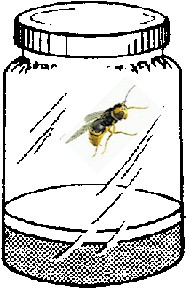An Insect Trap for Electrons

Antimatter is common enough at particle accelerators in the form of antiprotons and positrons, but no one has yet made neutral anti-atoms in a way that their properties could be accurately studied. One of the problems in making antihydrogen, for example, is that without some tricks, an approaching positron will usually fly straight past an antiproton, like a planetary probe lacking retrorockets to ease it into Martian orbit. In the 24 April PRL a Dutch and American team demonstrates a new technique for combining a free electron and an ion–temporary stand-ins for antimatter–by luring the electron with an electric field and then suddenly cutting the field when the electron is within the ion’s grasp.
For many years, Bart Noordam of the FOM Institute for Atomic and Molecular Physics in Amsterdam had used a standard ionization technique where a strong electric field removes a highly excited electron from an atom. The relative slowness of the electron’s escape gave him hope that he could reverse this so-called field ionization process, despite some colleagues’ early skepticism.
The idea is to first slow an electron as it travels “uphill” against an electric field. Just as it runs out of steam and prepares to turn back, the electron reaches the waiting ion, and the electric field is turned off, which traps the electron in a highly excited (Rydberg) state of the atom. The combination of the external electric field and the ion’s field creates a potential energy “hump” on the “downhill” side of the ion; eliminating the field raises the hump and traps the electron. As with nabbing a wasp in a jam jar, the key is to move quickly when the victim is over the target, says Noordam, and since switching off a 1.5 V/cm field in1 ns is not hard, the whole technique is “awfully easy.”
To implement their scheme, Noordam and his colleagues first placed a cloud of rubidium ions in a weak electric field and ionized them with a laser pulse. The laser blast sent the extra electrons away quickly but left the ions essentially stationery for the duration of the experiment. About 130 ns later, a pulse of electrons heading “uphill” reached the ions, just as the electric field was shut off. To analyze the resulting atoms, the team waited 2 µs before slowly ramping up the field again–this time to higher levels than before, to ionize the newly created atoms and determine their distribution of excited states. The quantum numbers for the excited electrons in these Rydberg atoms were between n = 123 and n = 200, and the distribution agreed well with a theoretical curve.
The system can now recombine about 1% of the ions, which makes it a “very encouraging step on the hard road to making cold anti-hydrogen,” assuming the electrons and ions are replaced by positrons and protons, says Gerald Gabrielse of Harvard University. He heads the large ATRAP collaboration of research groups (including Noordam’s) trying to make antihydrogen in order to test gravity and other fundamental physics using neutral antimatter. Thomas Gallagher of the University of Virginia says that using electric field pulses for recombination always seemed “so unlikely as to be a theoretical fantasy,” until related work was published by others two years ago. But the new research is the first demonstration using truly free electrons, he says, and it’s “an elegant piece of work.”


